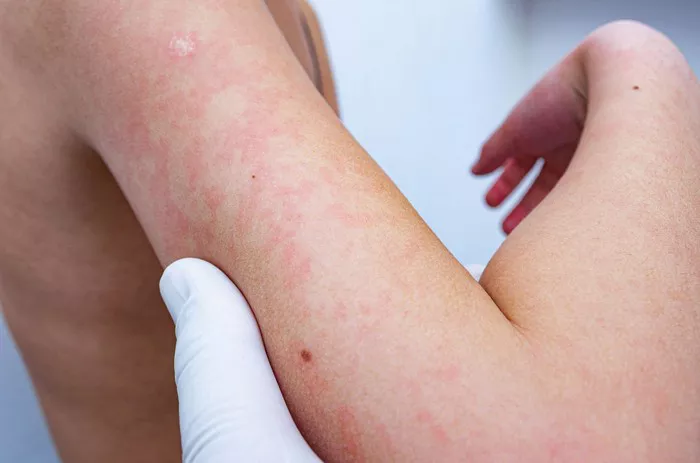Hives, also known as urticaria, are raised, itchy welts on the skin that often appear suddenly and can vary in size and shape. One common experience among individuals prone to hives is the phenomenon of hives appearing when the skin is scratched. This article delves into the reasons behind why scratching can trigger hives, exploring the underlying mechanisms, potential triggers, and effective management strategies.
Understanding Hives
Hives are a type of allergic reaction that affects the skin. They typically manifest as red or pink bumps or welts that can appear anywhere on the body. Hives are often accompanied by itching, which can range from mild to intense. The welts may vary in size, appearing as small dots or large patches, and can change shape and location within minutes to hours.
Mechanism of Hives Formation
Hives occur when certain cells in the skin release histamine and other chemicals into the bloodstream. These chemicals cause blood vessels to leak fluid into the skin, resulting in the characteristic swelling and itching associated with hives. The release of histamine is triggered by the immune system in response to various stimuli, which can include allergens, infections, stress, and other factors.
Why Scratching Can Trigger Hives
Scratching the skin can exacerbate or trigger hives through several mechanisms:
Histamine Release:
- Mechanical Stimulus: Scratching mechanically irritates the skin, which can trigger the release of histamine from mast cells and basophils in the skin.
- Histamine Response: Histamine causes blood vessels to dilate and become more permeable, leading to localized swelling (wheals) and itching. This response can intensify the hives and spread them to adjacent areas.
Koebner Phenomenon:
- Trauma Response: The Koebner phenomenon refers to the development of skin lesions or hives in areas of skin trauma or irritation. Scratching can induce this phenomenon, leading to the appearance of hives at the sites of scratching.
Delayed Pressure Urticaria:
- Pressure Induced Hives: In some cases, scratching or pressure on the skin can induce a specific type of hives known as delayed pressure urticaria. This condition causes hives to appear several hours after pressure or trauma to the skin, such as scratching.
Common Triggers for Scratching-Induced Hives
Several factors can contribute to hives appearing or worsening when the skin is scratched:
1. Allergens: Exposure to allergens, such as certain foods, medications, insect stings, or environmental triggers, can provoke an allergic reaction that manifests as hives. Scratching can exacerbate this reaction.
2. Physical Stimuli: Physical factors such as heat, cold, sunlight (solar urticaria), water (aquagenic urticaria), and pressure can trigger hives. Scratching may worsen the response to these stimuli.
3. Emotional Stress: Emotional stress or anxiety can trigger hives through the release of stress hormones and activation of the immune system. Scratching as a response to stress can aggravate hives.
4. Infections: Viral or bacterial infections can sometimes trigger hives. Scratching infected areas can spread the infection and worsen hives due to the inflammatory response.
Management Strategies for Scratching-Induced Hives
Managing hives that appear when the skin is scratched involves both prevention and treatment strategies:
Avoid Trigger Factors:
Identify and avoid known triggers for hives, including allergens, physical stimuli, and emotional stressors.
Gentle Skin Care:
Practice gentle skin care to minimize irritation and avoid scratching. Use mild soaps and moisturizers suitable for sensitive skin.
Cool Compresses:
Apply cool compresses or take cool baths to soothe itching and reduce inflammation.
SEE ALSO: Does Lack of Sleep Cause Hives?
Topical Treatments:
Use over-the-counter or prescribed antihistamine creams or lotions to relieve itching and inflammation.
Oral Antihistamines:
Take oral antihistamines as directed by a healthcare provider to reduce histamine release and alleviate symptoms.
Avoidance of Scratching:
Use techniques such as distraction, wearing gloves, or keeping fingernails short to minimize scratching.
Stress Management:
Practice stress-reduction techniques such as mindfulness, meditation, or yoga to help manage emotional triggers for hives.
Medical Evaluation:
If hives are severe, recurrent, or persistent despite home care measures, consult a dermatologist or allergist for further evaluation and management.
Conclusion
Hives that appear when the skin is scratched are a common manifestation of allergic reactions and other underlying factors. Understanding the mechanisms behind why scratching can trigger hives, including histamine release and the Koebner phenomenon, is essential for effective management. By identifying and avoiding triggers, practicing gentle skin care, using appropriate treatments, and managing stress, individuals prone to scratching-induced hives can minimize symptoms and improve their quality of life. Consultation with a healthcare provider can provide personalized guidance and treatment options tailored to individual needs and circumstances.
Related Topics:

























